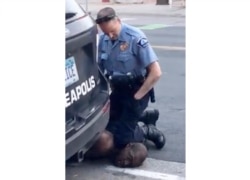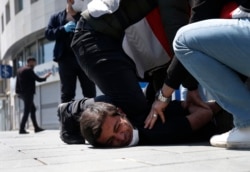George Floyd died on May 25 after an American police officer pressed his leg on Floyd’s neck for several minutes during an arrest in Minneapolis, Minnesota. Three days later, another black man struggled to breathe under the knee of a French police officer on the streets of Paris.
The arrest methods in which officers restrain suspects by the neck to prevent them from moving are used around the world. They are known as chokeholds. Critics have long blamed the methods for cutting off oxygen and, in some cases, causing death.
“We cannot say that the American situation is foreign to us,” said French lawmaker Francois Ruffin. He has been pushing for a ban on chokeholds. But the legislative effort has been delayed by the coronavirus crisis.
The May 28 arrest in Paris of the black man is among those being compared to what happened to Floyd in Minneapolis. The Paris arrest was filmed and widely shared online.
In Hong Kong, clashes between police and pro-democracy protesters have gone on for some time. The territory’s officials say they are investigating the death of a man who was held face-down during his arrest in May. The arresting officers were filmed kneeling on his shoulder, back and neck.
Police rules and policies on chokeholds and restraints are different from country to country.
In Belgium, police trainer Stany Durieux says he warns trainees every time he sees a “knee applied to the spinal column.” He added, “It is also forbidden to lean on a suspect completely.” This, he said, can crush a suspect's ribs and make it impossible for them to breathe.
A spokesman for Israeli police says forces there are not permitted “to put pressure on the neck or airway” during an arrest. But Human Rights Watch reported that Israeli border police have used chokeholds on Palestinian children as young as 11.
In Germany, the police union says officers are permitted to put pressure on the side of a suspect’s head for a short time -- but not on the neck.
The College of Policing in Britain says suspects should be placed on their side or in a sitting, kneeling or standing position “as soon as practicable.” London’s police website says “any form of pressure to the neck area can be highly dangerous.”
Even within one country, the rules and policies for arresting a suspect can differ.
The New York Police Department’s guide says that officers “SHALL NOT” use chokeholds. It also says officers should avoid any actions that may put extreme pressure on a suspect’s chest area.
But another method of restraint, in which pressure is applied to the neck with an arm was permitted for police in San Diego, California. After Floyd’s death last week, San Diego Police Chief David Nisleit said he would order an end to the method.
France’s head of training for police forces in rural areas, Laurent de Joux, says officers are told to avoid pressing down on the chests. They also are no longer taught to put pressure to the neck. “You don’t need to be a doctor to understand that this is dangerous,” de Joux added.
But rules issued in 2015 for the French National Police in cities and urban areas permit officers to apply pressure for a short time on a suspect’s chest.
Christophe Rouget, a police union official in France, defended the method. He said such methods “are used by all the police in the world because they represent the least amount of danger. The only thing is that they have to be well used," he said. "In the United States, we saw that it wasn’t well used, with pressure applied in the wrong place and for too long.”
He added that the “real problem” in France is that officers do not get enough continued training after being taught restraints in police school.
“You need to repeat them often to do them well,” Rouget said.
I'm Ashley Thompson.
Hai Do adapted this story for Learning English from an Associated Press news report. Ashley Thompson was the editor.
________________________________________________________________
Words in This Story
apply - v. to cause force or pressure on something
spinal column - n. backbones that provide support for the entire body
forbid - v. to say that something is not permitted
lean - v. to rest on or against by force
practicable - adj. able to be done or used












